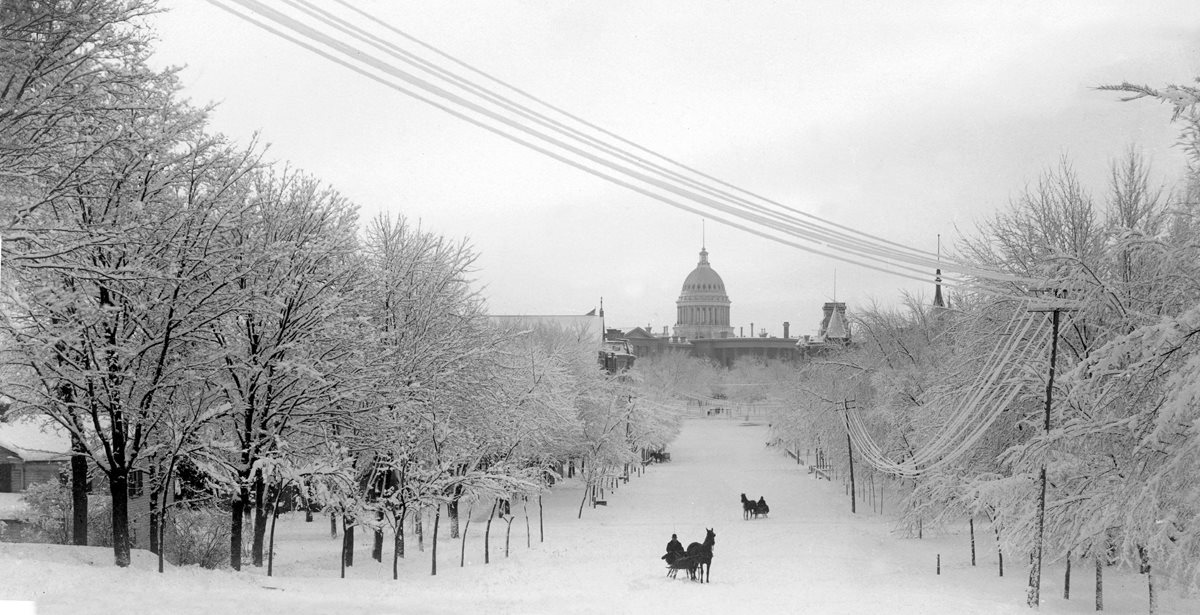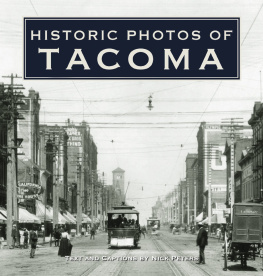
HISTORIC PHOTOS OF
MADISON
TEXT AND CAPTIONS BY DONALD J. JOHNSON


Three horse-drawn sleighs can be seen in this 1898 photograph. The view looks down Wisconsin Avenue toward Madisons second Wisconsin Capitol. The automobile arrived in Madison a few short years later. Albert Zimmerman purchased a Locomobile steamer, which sold for about $600, in 1902, claiming it was the first permanent automobile in the capital city.
HISTORIC PHOTOS OF
MADISON
Turner Publishing Company
200 4th Avenue North Suite 950
Nashville, Tennessee 37219
(615) 255-2665
412 Broadway P.O. Box 3101
Paducah, Kentucky 42002-3101
(270) 443-0121
www.turnerpublishing.com
Historic Photos of Madison
Copyright 2007 Turner Publishing Company
All rights reserved.
This book or any part thereof may not be reproduced or transmitted in any form or by any means, electronic or mechanical, including photocopying, recording, or by any information storage and retrieval system, without permission in writing from the publisher.
Library of Congress Control Number: 2007923668
ISBN-13: 978-1-59652-335-7
ISBN: 1-59652-335-2
Printed in the United States of America
07 08 09 10 11 12 13 140 9 8 7 6 5 4 3 2 1
CONTENTS

H. H. Bennett, one of the premier photographers of the era, took this group portrait of the 16th Wisconsin Volunteer Infantry, together with their wives and families, during their first reunion in Madison on September 7, 1887, twenty-two years after they were mustered out. Bennett, a veteran of the 12th Wisconsin Volunteer Infantry, may have included some members of his regiment as well.
ACKNOWLEDGMENTS
This volume, Historic Photos of Madison, is the result of the cooperation and efforts of many individuals and organizations. In particular, its creation would not be possible without the world-class resources of the Wisconsin Historical Society and the University of Wisconsin-Madison libraries, which include the University Archives. It is with great thanks that we acknowledge those valuable contributions.
This project represents countless hours of review and research. The researchers and writer have reviewed thousands of photographs. We greatly appreciate the generous assistance of the archives listed here, without whom this project could not have been completed.
The goal in publishing this work is to provide broader access to a set of extraordinary photographs. The aim is to inspire, provide perspective, and evoke insight that might assist officials and citizens, who together are responsible for determining Madisons future. In addition, the book seeks to preserve the past with respect and reverence.
With the exception of touching up imperfections caused by the vicissitudes of time and cropping where necessary, no other changes have been made. The focus and clarity of many images is limited to the technology of the day and the skill of the photographer who captured them.
We encourage readers to reflect as they explore Madison, stroll along its streets, or wander its neighborhoods. It is the publishers hope that in making use of this work, longtime residents will learn something new and that new residents will gain a perspective on where Madison has been, so that each can contribute to its future.
Todd Bottorff, Publisher
This book is a tribute with love to my family and to Madison.
To my wife, Debra, and to my son, Jared, and to my father and mother, Rodney and Frances Johnson.
Donald J. Johnson, Author
PREFACE
In less than thirty years, Madison will touch upon its 200th anniversary. The land that is now the home of the capital city of Wisconsin was surveyed in 1834. It was put up for sale in 1835 by the federal government, and the first road was built through the area by soldiers under the command of a future president, Zachary Taylor. Within two years after being surveyed, Madison appeared on paper when James Doty drew up the plat map for Madison, named for the former president and author of the U.S. Constitution; streets were named after Madisons colleagues, who worked with him in crafting the worlds first blueprint for democracy.
Later that same year, the legislature of the newly created Wisconsin territory selected Madison, which had no permanent residents, as the territorial capital, replacing Belmont. The first settler arrived the next year in 1837. By 1848, barely fourteen years after being surveyed, the land hosted more than a thousand settlers and had since become the capital city of a newly christened state in the union.
The story that evolved since then is as intricate as any complex family history. The photographs selected for this volume after countless hours of work by researchers and editors constitute one of many possible albums showing that history. Although other collections could be equally interesting, none, including this one, can promise to be more than a series of glimpses into that past and what we think was true. We try to provide a balanced sample, drawing from the principal forces that affected peoples livescommerce, politics, religion, education, and transportation.
Many writers, too many to mention, have worked with great care to preserve parts, if not the whole, of the citys history in books, pamphlets, and web sites. Our most reliable sources can be found among the rich primary source documents and treasures in the Wisconsin Historical Society and in the states many libraries. This book does not attempt to compete as a comprehensive historical record. For such accounts, both collective and personal, there are histories and daily stories by historians and journalists such as Stuart Levitan, Reuben Gold Thwaites, David Mollenhoff, William Wineke, Susan Lampert Smith, Frank Custer.
The inspiration for the book does, however, match their love for a place and for the people who make it uniquerich with history and diverse experiencesa home that few want to leave and to which many return. Like other families, we have argued fervently among ourselves about how we should care for our beloved Madison and what its future should hold. Future debates promise to be just as ardent. Will such discussions ever settle at an angle of repose as in the title from the Pulitzer Prizewinning novel by former Madisonian Wallace Stegner? Probably not soon. Although we can reflect, sometimes with awe and at other times with amusement, our story is yet still too young to look back for long. Perhaps our best tack is to remember what we hold dear about Madison and let that be our guide in building our future community.
Donald J. Johnson

Part of a Labor Day parade featuring a float shaped like a boat turns off the Capitol Square in 1918. The photograph was taken by William Meuer, a well-known Madison photographer, who chronicled the famous and not-so-famous in Madisons history from the late 1800s through 1934. His collection of more than 28,000 black-and-white photographs is housed in the University Archives of the University of Wisconsin-Madison libraries. Topics range from faculty portraits, new scientific discoveries, athletics, students, governors of Wisconsin, and images of Madison.
Next page
















